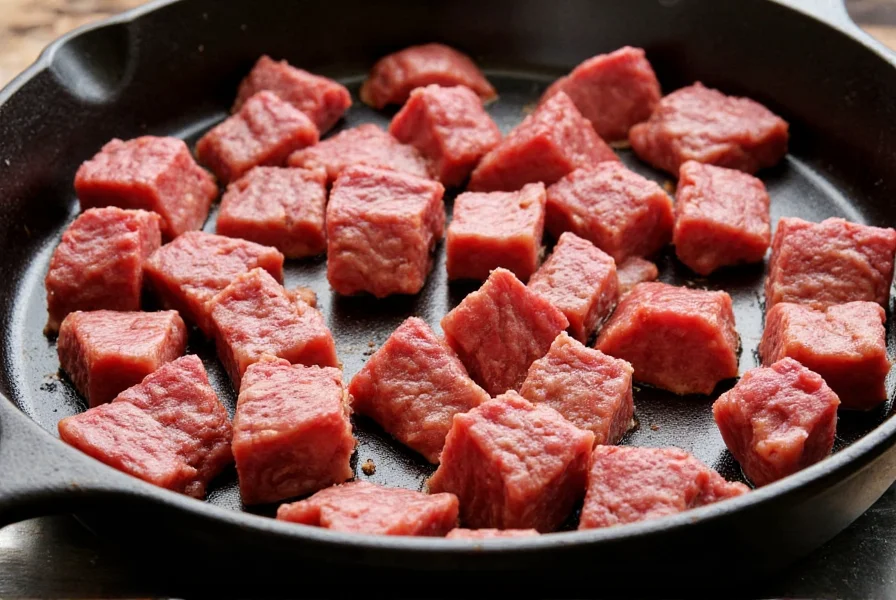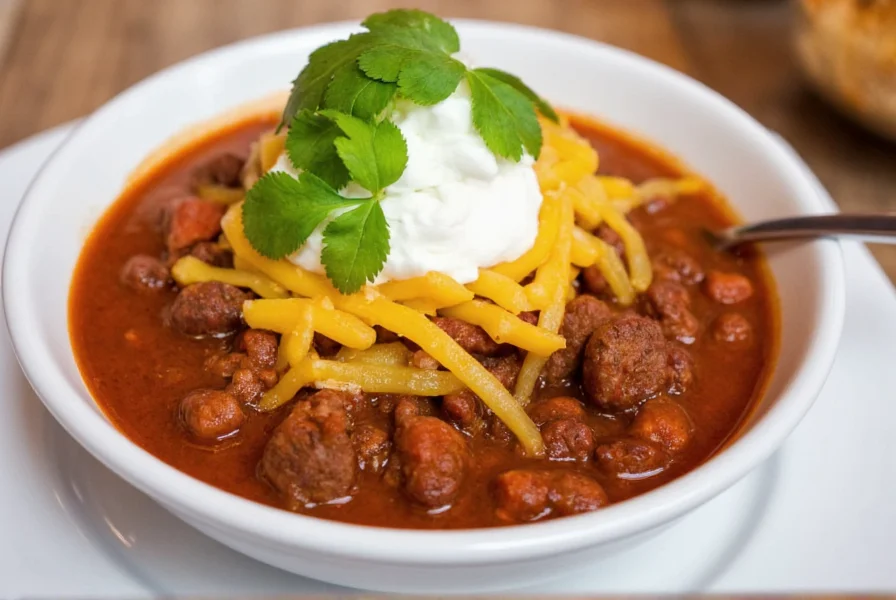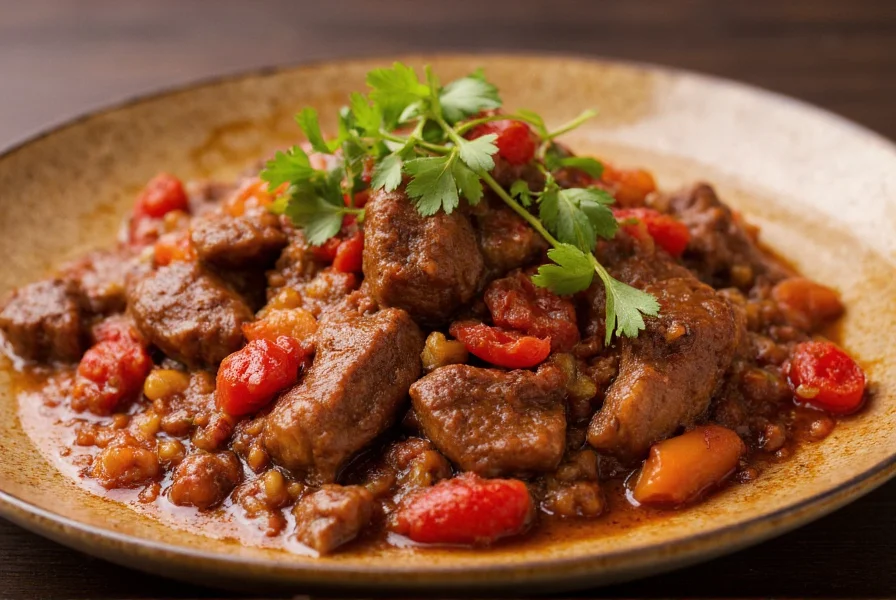When crafted properly, steak chili delivers a superior texture experience compared to ground beef versions, with distinct meat pieces that absorb flavors while retaining their integrity. This meat-centric approach creates a more substantial, restaurant-quality dish that stands apart from conventional chili recipes.
What Makes Steak Chili Distinctive
Steak chili represents a culinary evolution from traditional chili con carne. While standard chili typically relies on ground beef, steak chili features cubed cuts of beef that provide textural contrast and a more pronounced beef flavor. The key difference lies in the meat preparation: steak chili requires careful cubing of quality cuts, proper searing to develop fond, and extended simmering to achieve fork-tender results without disintegration.
Professional chefs prefer steak chili for special occasions because it demonstrates greater technical skill and yields more impressive results. The visible chunks of meat create visual appeal that ground beef simply cannot match, making it ideal for entertaining or when you want to elevate a classic comfort food.
Optimal Steak Cuts for Chili
Selecting the right cut of beef is the most critical decision when preparing steak chili. Not all cuts respond equally to the long cooking process required for proper flavor development. The ideal cuts balance marbling, connective tissue, and flavor profile to withstand extended simmering while maintaining structural integrity.
| Cut of Beef | Marbling Level | Cooking Time | Flavor Profile | Best For |
|---|---|---|---|---|
| Chuck Roast | High | 2-2.5 hours | Rich, beefy | Traditional hearty chili |
| Brisket | Very High | 2.5-3 hours | Deep, complex | Smoky, robust chili |
| Sirloin | Moderate | 1.5-2 hours | Clean, lean | Lighter texture chili |
| Short Ribs | Exceptional | 3+ hours | Intense, luxurious | Special occasion chili |
Chuck roast remains the most popular choice for steak chili due to its ideal balance of fat content and connective tissue, which breaks down during cooking to create natural thickening and rich mouthfeel. Brisket offers exceptional flavor complexity but requires longer cooking. Sirloin provides a leaner option that maintains distinct texture but lacks the richness of fattier cuts.

Essential Ingredients for Flavor Development
The foundation of exceptional steak chili rests on more than just quality meat. Building layered flavors requires strategic ingredient selection and proper technique:
- Aromatics: Yellow onions provide the essential base, while poblano peppers add subtle heat without overwhelming spice
- Tomato component: Crushed tomatoes offer acidity and body, while tomato paste caramelized during searing creates depth
- Liquid component: A combination of beef broth and dark beer creates complex flavor notes that water alone cannot achieve
- Spice blend: A custom mix of ancho chili powder, cumin, smoked paprika, and a touch of cinnamon creates balanced warmth
- Umami boosters: Soy sauce or Worcestershire sauce in small amounts enhances meatiness without being detectable
Professional chefs often add a small piece of dark chocolate during the final simmering stage to round out flavors and add subtle complexity—a technique that transforms good steak chili into exceptional chili.
Step-by-Step Steak Chili Preparation
Creating perfect steak chili requires attention to specific techniques that maximize flavor development while preserving meat texture:
- Proper meat preparation: Cut steak into uniform 3/4-inch cubes, pat completely dry, and season generously with salt and pepper before cooking
- Strategic searing: Sear meat in small batches in smoking-hot oil, allowing proper browning without overcrowding the pan
- Fond development: After removing meat, cook aromatics in the same pot to incorporate the flavorful browned bits
- Spice blooming: Toast dry spices with aromatics to release essential oils before adding liquids
- Layered liquid addition: Deglaze with beer first, then add tomatoes and broth for optimal flavor integration
- Controlled simmering: Maintain a gentle bubble (180-200°F) rather than a rolling boil to prevent meat from becoming tough
- Resting period: Allow chili to rest off heat for 15-20 minutes before serving to let flavors marry and meat reabsorb juices
Avoiding Common Steak Chili Mistakes
Even experienced cooks make critical errors when preparing steak chili that compromise the final dish:
- Overcrowding the pan during searing: Causes steaming instead of browning, resulting in gray, flavorless meat
- Adding cold liquid to hot pot: Causes rapid temperature drop that prevents proper fond incorporation
- Boiling instead of simmering: Makes meat tough and causes disintegration of properly seared pieces
- Insufficient seasoning between layers: Each component (meat, aromatics, spices) needs proper seasoning
- Serving immediately after cooking: Prevents flavors from properly melding and integrating
One professional technique that elevates steak chili is the "two-stage cooking" method: sear and brown all components, then transfer to a low oven (275°F) for 2-3 hours. This gentle, even heat produces more consistent results than stovetop simmering alone.
Serving Suggestions and Pairings
Steak chili's robust flavor profile demands thoughtful accompaniments that complement rather than compete with its complexity:
- Classic toppings: Sharp cheddar, sour cream, and fresh cilantro provide cooling contrast to the rich meat
- Texture elements: Crumbled corn chips or fried tortilla strips add welcome crunch against the tender meat
- Bread pairings: Crusty artisan bread or cornbread with honey balances the savory richness
- Side dishes: Simple green salad with vinaigrette cuts through the heaviness of the chili
- Beverage pairings: Medium-bodied red wines like Malbec or dark lagers complement the beefy flavors

Storage and Leftover Transformation
Steak chili often improves with time as flavors continue to develop. Proper storage techniques maintain quality while opening possibilities for creative reuse:
- Refrigerate in airtight containers for up to 4 days—flavors deepen noticeably after 24 hours
- Freeze in portion-sized containers for up to 3 months without quality loss
- Reheat gently over low heat with a splash of broth to restore moisture
- Transform leftovers into chili cheese fries, chili-topped baked potatoes, or chili-stuffed bell peppers
- Use as a base for hearty beef stew by adding root vegetables and adjusting liquid ratio
Unlike ground beef chili, steak chili maintains its distinctive meat pieces through multiple reheating cycles, making it particularly well-suited for meal prep and entertaining.











 浙公网安备
33010002000092号
浙公网安备
33010002000092号 浙B2-20120091-4
浙B2-20120091-4